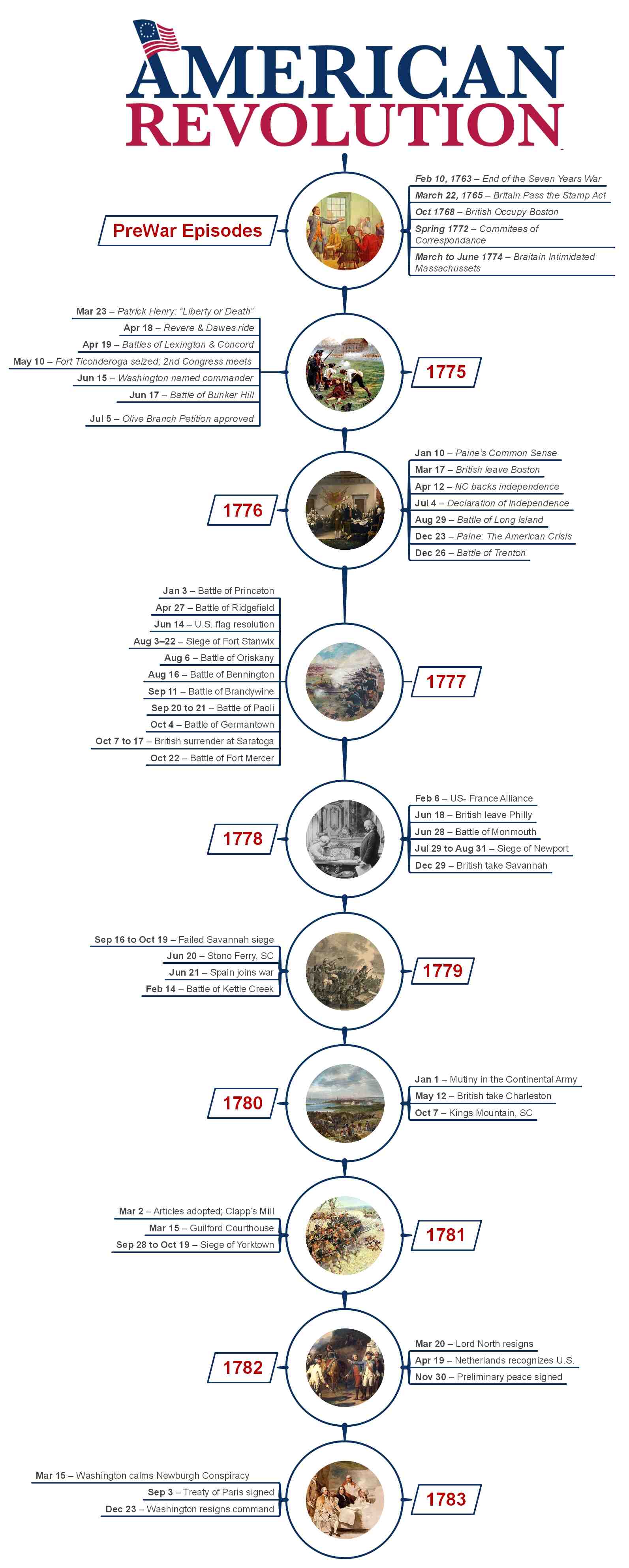What started as thirteen British colonies rebelling against oppression became an arduous eight-year-long war of independence for North America. Ending in 1783, the war followed the colonies achieving political independence and establishing a new state, the USA. However, the inclusion of international actors, growing civil unrest, and naval confrontations makes this episode puzzling for readers.
But worry not! This easy-to-follow American Revolutionary War timeline offers a clear glimpse of key chronological events, helping you make better sense of the period.
In this article
Part 1: American Revolutionary War Timeline in Order
Lead-in to War: 1763 - 1774
- February 10, 1763 - End of the Seven-Year War
The first Treaty of Paris ended the French and Indian War. France surrendered to Britain, ending the insecurity of the British colonists on the Atlantic Coast. - March 22, 1765 - The British Passed the Stamp Act
The British passed the Stamp Act. According to it, everything, including the newspapers, documents, and playing cards, was taxed. - October 1768 - British Troops Occupy Boston
British forces landed in Boston to enforce the taxes and duties. This frustrated the colonies significantly, leading to routine confrontations. One such clash in 1770 led to five people dying, later known as the Boston Massacre. - Spring 1772 - Establishment of the Committees of Correspondence
Given the rising tension in the colonies, the British established the Committees of Correspondence. This would help the colonisers in cooperation and mutual action. - March to June 1774 - Britain Intimidated Massachusetts
The British passed the Coercive Acts, also called the Intolerable Acts, in Massachusetts. It held all the colonies together, prompting a b response.
1775
- March 23 - Liberty or Death Speech
Patrick Henry gives his passionate speech about the liberty of the colonies, called Give me Liberty or Give me Death. It became the symbolic cry of revolts. - April 18 - Revere and Dawes Ride
Paul Revere traveled to Lexington to warn the revolutionaries about the British march toward Concord. - April 19 - Battle of Lexington and Concord
The first battle of the American Revolutionary War took place in Lexington. No one knows who first started the offence. - May 10 - Fort Ticonderoga Seized
Benedict Arnold's Mountain Boys seized Fort Ticonderoga. It boosted the morale of the revolutionaries during the early war days. - June 15 - Washington Took Control of the Army
George Washington became the commander-in-chief of the American Army. This army was later called the Continental Army. - June 17 - Battle of Bunker Hill
Revolutionaries started their first major military engagement at Bunker Hill, today's Boston. However, the British won the war despite a heavy cost. - July 5 - Olive Branch Petition
The colonies sent a formal declaration to King George III. It was an attempt by the second Continental Congress to prevent a full-fledged war.
1776
- January 10 - Common Sense by Thomas Paine
Thomas Paine's text significantly influenced the public's perception of the independent colonies. It also established him as the greatest political writer to date. - March 17 - British Evacuate Boston
The Continental Army under the leadership of Washington succeeded in Boston. This marks the retreat of William Howe from Boston. - April 12 - Halifax Resolves
The Fourth North Carolina Provincial Congress passed the Halifax Resolve. It called for complete independence of the colonies from Britain. - July 4 - Declaration of Independence
Congress finalized the call for independence. It was signed by all 13 colonies, gaining complete separation from Britain. - August 29 - Battle of Long Island
Following the Declaration of Independence, Britain won their first battle. Washington and his army escaped to the East River. - December 23 - The American Crisis by Thomas Paine
Thomas Paine's The American Crisis was popularized among the masses. It was also made compulsory to be read by the army. - December 26 - Battle of Trenton
The Continental Army won the battle at Trenton. Standout officers in the battle included Lieutenant James Monroe (future president) and artillery Captain Alexander Hamilton (future secretary of the treasury).
1777
- January 3 - Battle of Princeton
The Continental Army under George Washington won the Battle of Princeton. - April 27 - Battle of Ridgefield
British forces under Maj. Gen William Tryon raided Ridgefield in an attempt to destroy the Continental Army's supplies. Ultimately, the Britishers broke through the Continental Army's barricades. - June 14 - Flag Resolution
The Second Continental Congress passed the American Flag Resolution. The flag was designed with stars and stripes to represent the new arrangement. - August 3 to 22 - Siege of Fort Stanwix
British Brig. Gen Barry St. Leger sent his troops to capture Fort Stanwix. Upon confrontation, both sides settle in for a siege. - August 6 - Battle of Oriskany
Both forces confronted at Oriskany. It was one of the few battles where all the participants from both sides were North American. The Continental Army, however, succeeded in pushing the British forces. - August 16 - Battle of Bennington
British forces, once again, attempted to seize the Continental Army's supplies. However, the American Army under Gen. John Stark gained a victory. - September 11 - Battle of Brandywine
The Battle of Bennington marks another major confrontation between the two forces. It ended with the Britishers capturing Philadelphia. - September 20 to 21 - Battle of Paoli
British forces launch a surprise offensive at night in Philadelphia. It caused massive American casualties. - October 4 - Battle of Germantown
In an attempt to free Philadelphia, Americans launched an offensive in Germantown. However, despite early achievements, the offence didn't turn out in their favor. - October 7 to 17 - Battle of Saratoga
The Battle of Saratoga turned in favor of the Continental Army. British Gen. John Burgoyne surrendered, resulting in the Convention of Saratoga. - October 22 - Battle of Fort Mercer
Hessian soldiers from the British army attempted to take Fort Mercer. However, the Continental Army won, leaving Hessians with massive casualties.
1778
- February 6 - France Became a US Ally
Following the Continental Army's win at Saratoga, France aligned with the colonies, agreeing to two treaties of military assistance. - June 18 - The British Abandon Philadelphia
Britain, after almost nine months of the Philadelphia occupation, left under the leadership of General Sir Henry Clinton. - June 28 - Battle of Monmouth
Gen Charles Lee of the Continental Army led confused orders. George Washington later replaced him. Although the Americans won the war, the British had already escaped to New York. - July 29 to August 31 - French and American Forces Besiege Newport
The French and Americans launched an offensive in an attempt to siege the Rohde Islands, Newport. However, by August 29, they finally withdrew their forces. - December 29 - British Capture Savannah
British forces under Lieutenant Colonel Archibald Campbell launched a surprise attack to defend Savannah. The Americans suffered heavy losses.
1779
- February 14 - Battle of Kettle Creek
The patriot militias gained victory against the loyalists in Georgia. Meanwhile, British captain James Cook was killed on the Sandwich Islands. - June 20 - Battle of Stono Ferry
The British suffered great losses, and the war ended with the Americans gaining victory in South Carolina. - June 21 - Spain Declares War on Great Britain
Spain formed a de facto alliance with the American colonies and joined France in supporting the Continental Army. - September 16 to October 19 - American/French Effort to Retake Savannah fails
American and French forces attempted to retake the Savannah port, yet failed. It was one of the deadliest confrontations for the Americans.
1780
- January 1 - Mutiny in the Continental Army
A mutiny occurs in the Continental Army due to the currency sinking. It was short-lived; the army soon began regular operations. - May 12 - Charleston Falls to the British
British, after a short confrontation, captured Charleston along with 5400 men and four American ships. - October 7 - Kings Mountain Claimed Victory
The Patriot militia defeated a force of loyalists at Kings Mountain.
1781
- March 2 - Articles of Confederation
The Articles of Confederation, passed by the Americans in 1777, were finally ratified. - March 15 - Guildford Courthouse
British forces won over the militias in the Guildford Courthouse; however, it was a costly victory. - September 28 to October 19 - Siege of Yorktown
The French and American forces trapped the British army in Yorktown. They were unable to evacuate or call for reinforcements. Hence, Gen Cornswallis was forced to surrender, marking the deadliest surrender of the war.
1782
- March 20 - Lord North Resigns
Lord North resigns from his position as British Prime Minister, given the opposition from the parliament. - April 19 - Netherlands Recognized American Independence
The Netherlands became the second country to formally recognize the independent United States, following Morocco in 1777. - November 30 - Preliminary Articles of Peace
The British and Americans signed the preliminary articles of peace, a substantial step towards an independent America.
1783
- March 15 - Newburgh Conspiracy
Washington made a surprise entry in the army officers' assembly at Newburgh. He addressed the conspiracy and distrust among the soldiers, calming the revolt. - September 3 - Treaty of Paris
The American Revolution ended with the Paris Treaty between the two parties. The resultant independent nation was named the United States. - December 23 - Washington Resigns
George Washington resigns his commission. This event set the precedent of civilian control over the military in the USA.
Part 2: How to Make Such a Timeline using EdrawMind?
See how easy it was to capture the entire eight years into a small yet informative timeline. You can do the same, even without any design skills, with EdrawMind, a free online timeline maker, which features an advanced toolkit with design elements, ample canvas space, and additional functions.
Let's see how we made this American Revolutionary War timeline using this tool.
Step 1: Open a Blank Canvas
Download and install the EdrawMind desktop version. Or use EdrawMind online.
Log in to your Wondershare account. Alternatively, access the software using your Google or Facebook account.
Explore the dashboard and click Create > Local Mind Map. It will take you to the canvas space.
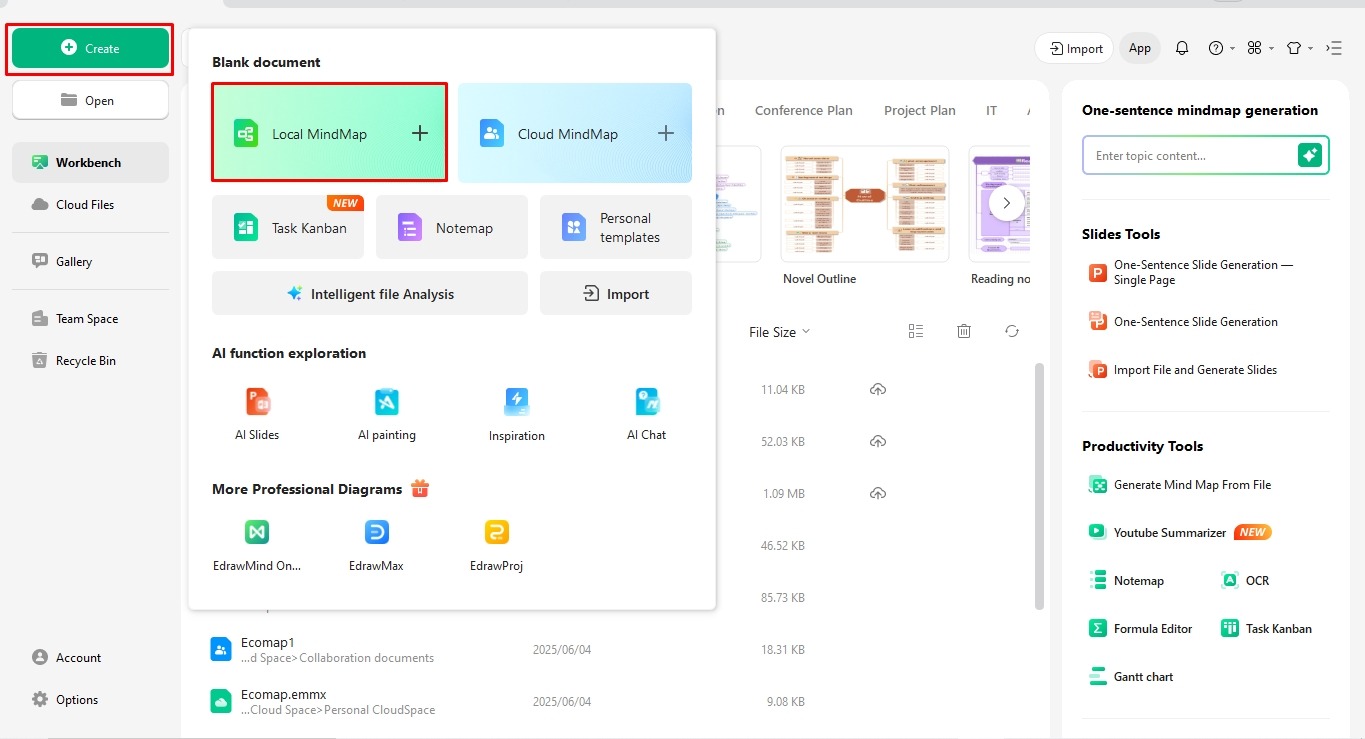
Step 2: Adjust the Layout
Structure is the foundation of your timeline. You must take your time to consider whether the data is best suited for a vertical, horizontal, or snake-like format. As the default structure is set to mind map, let's switch it to the timeline.
The events of the American Revolutionary War timeline demand a vertical chronology.
So, select your Main Idea box and click Layout. Choose Vertical Timeline from the menu.
You also have the freedom to go top-to-bottom or vice versa with these layout options.
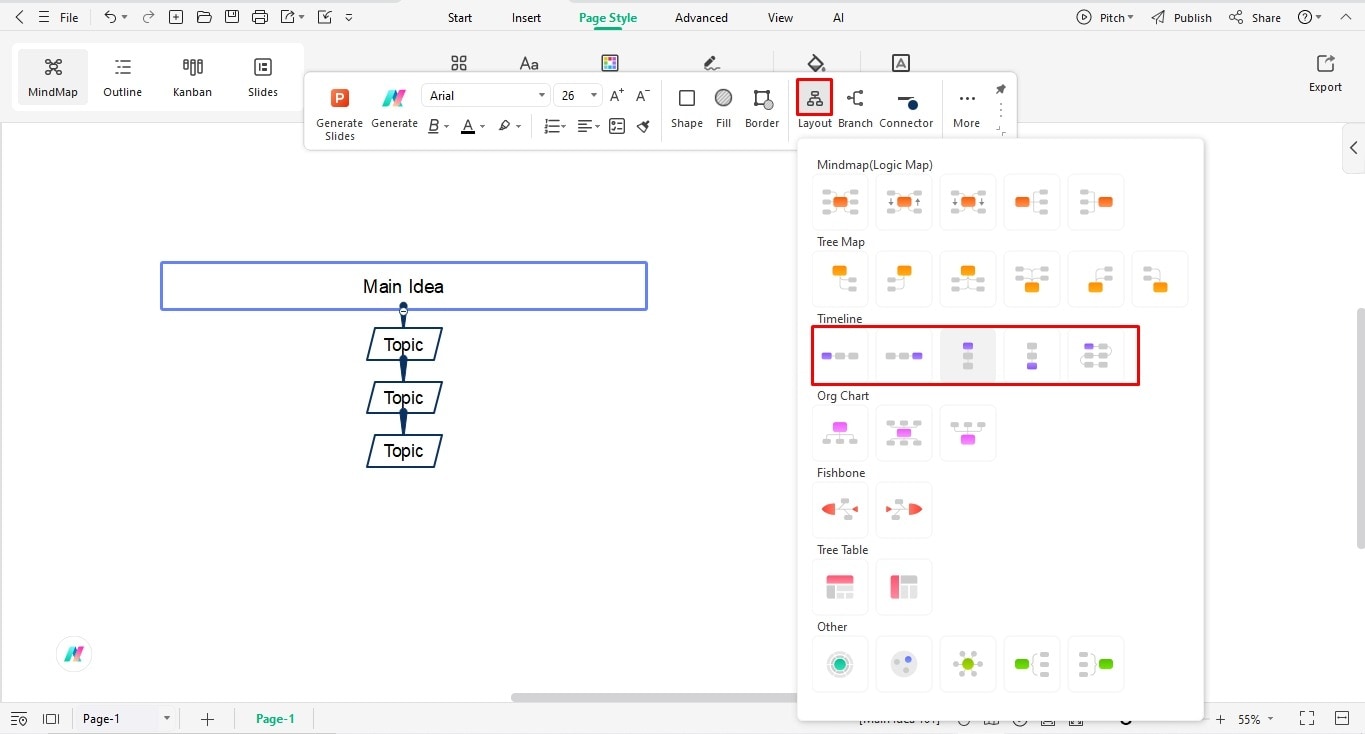
Step 3: Add Topics and Sub-Topics
The next step is expanding the structure of your timeline. Review your data and note the number of milestones. You also need to have a clear idea of the sub-branches each milestone would require.
For instance, the US revolutionary timeline has nine milestones, which means we will have nine topic idea boxes.
Select the Main Idea box and click More. Add Topic, Sub-Topic, Floating Topic, etc.
You can also add callouts, summaries, etc., for supplementary information.
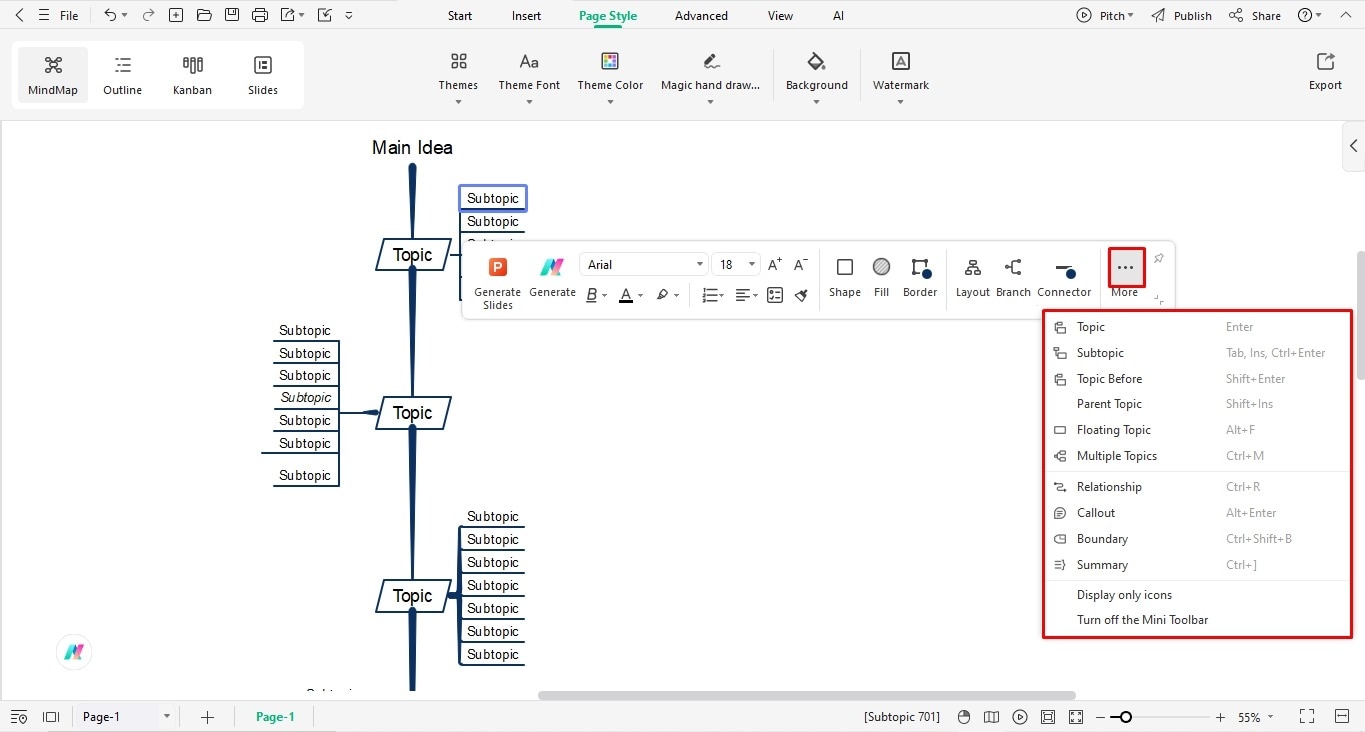
Step 4: Insert Text Labels
Once the structure is in place, let's move forward to adding text labels.
To do this, double-click any box and start typing.
Modify the font details (shape, style, size, color) from the on-screen prompt.
Similarly, add your event descriptions accordingly in the sub-branches.
You can also optimize these descriptions with Edraw AI. It helps you adjust your tone, translate text, or shorten it.
Simply click Generate from the menu and select the desired operation.
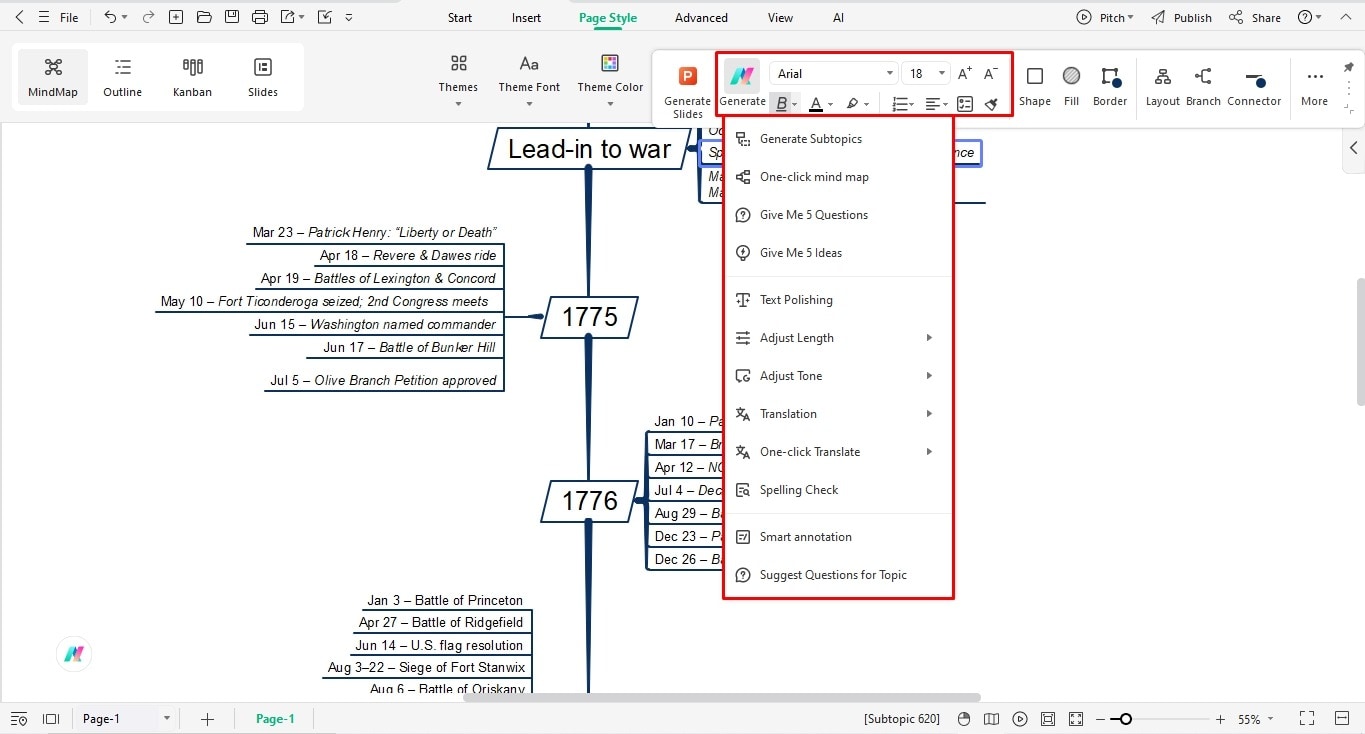
Step 5: Add Pictures
Now comes the exciting part - adding pictures to your timeline. Visual cues provide your audience with something to hold onto and better register the events.
Visit the Insert tab at the top and click Picture. Browse your desired image from the device.
Crop, rotate, or fine-tune the image using the on-screen prompt. Click Location to decide where you want to paste it (right, left, middle, etc).
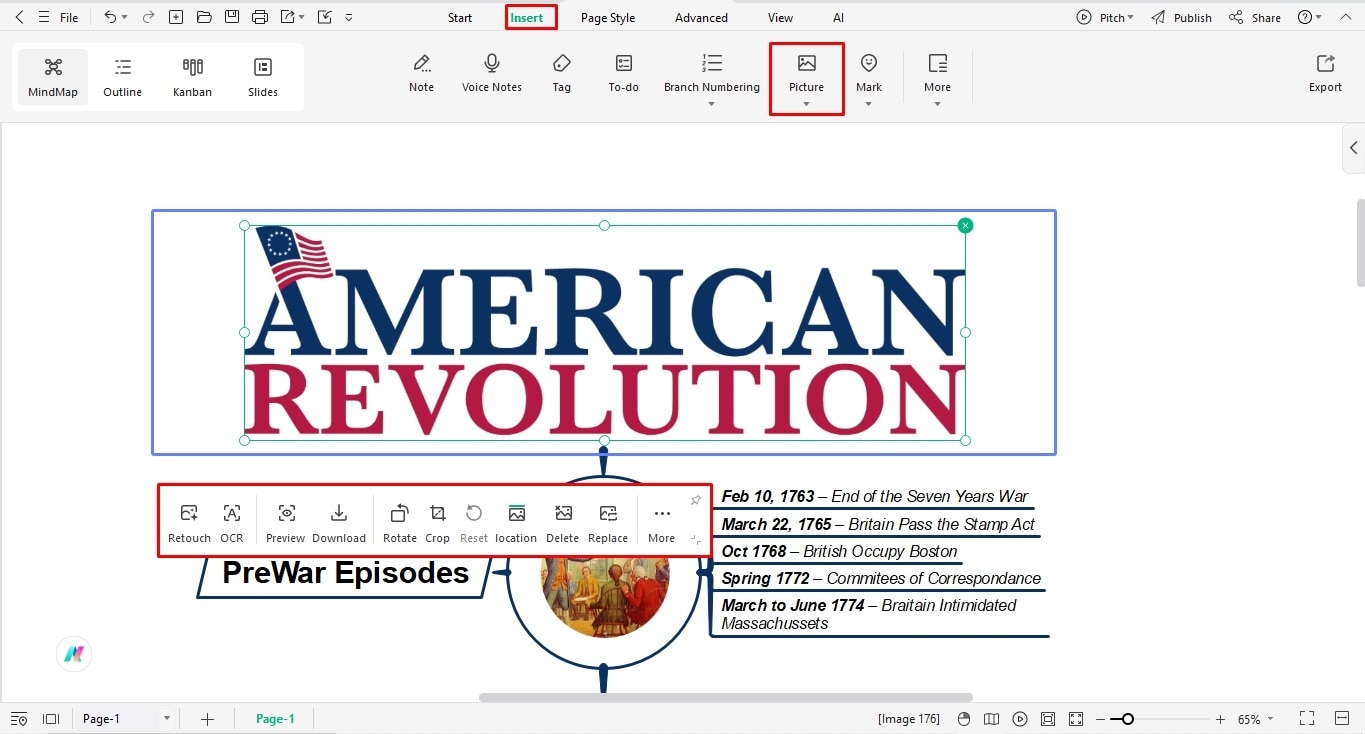
Step 6: Modify Design Details
You're almost there. Just a few design fine-tunes, and you're done.
Locate the Page Layout tab at the top. Modify the theme, color scheme, and image background accordingly.
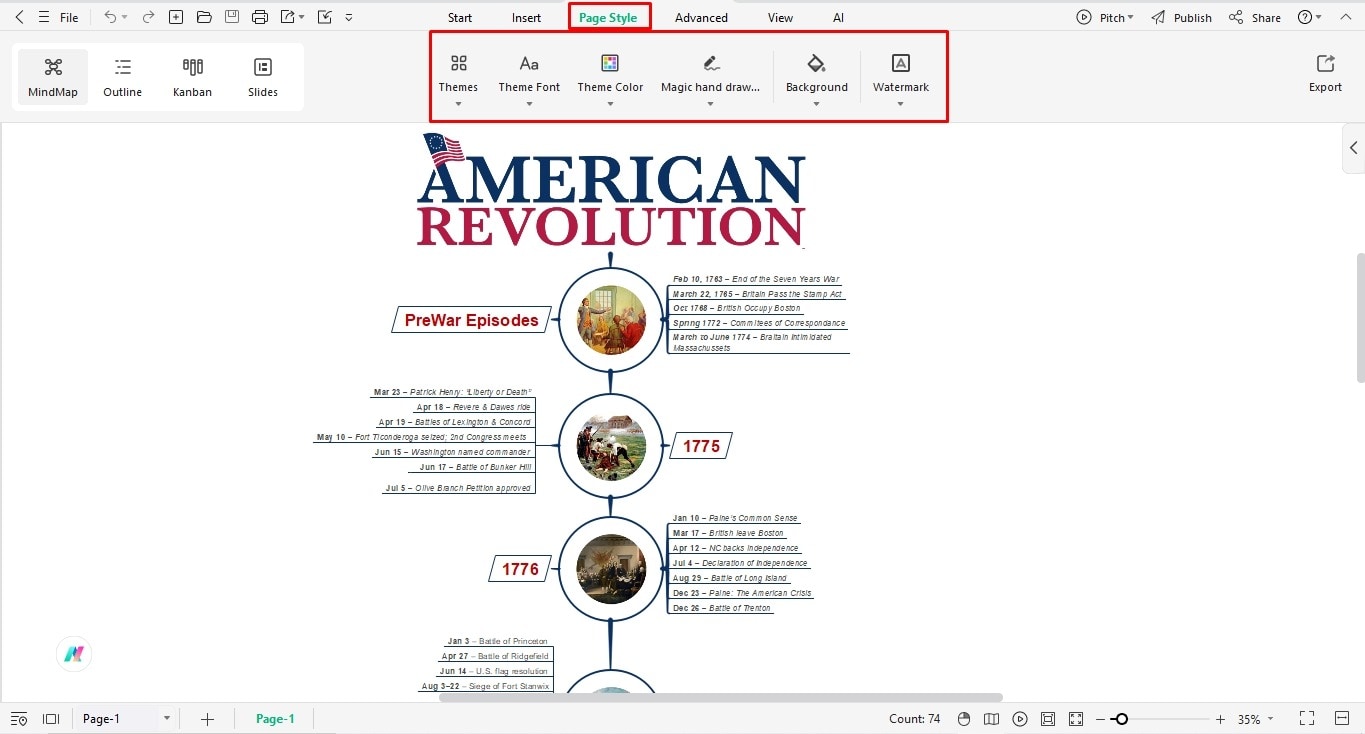
Pro Tip: You can also create a custom theme with a relevant color palette to use in any infographic you make in the future.
Step 7: Download Your Work!
Satisfied with the infographic? Download your work however you like.
Click the Export icon from the quick-access toolbar and choose your desired format: Graphics (PNG, JPG, JPEG, etc), MS Office (Word, PPT, XLSL, and Visio), or PDF document.
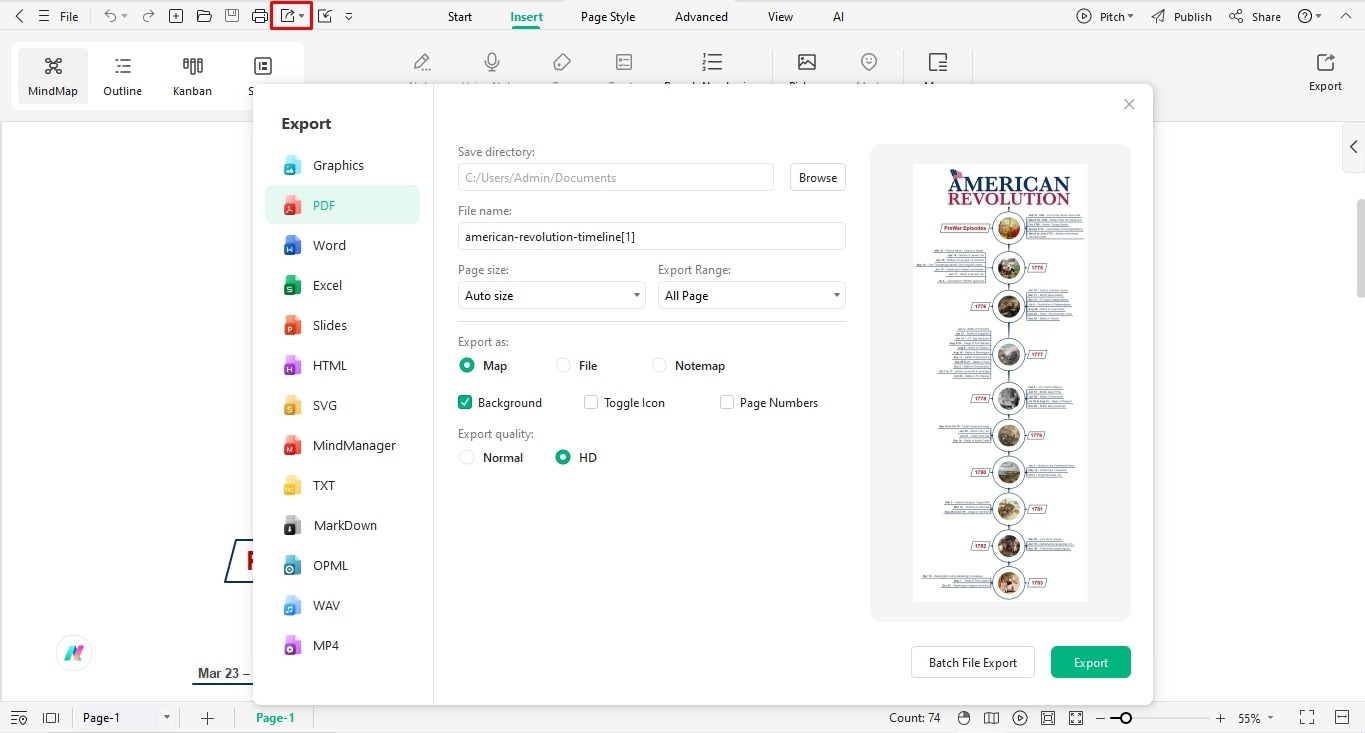
Step 8: Get Instant Feedback
Want feedback on your assignment from peers and colleagues? EdrawMind makes it easy with the real-time collaboration function. It lets multiple users comment and edit the diagram simultaneously.
For this, click Share from the quick-access toolbar and invite people using their emails.
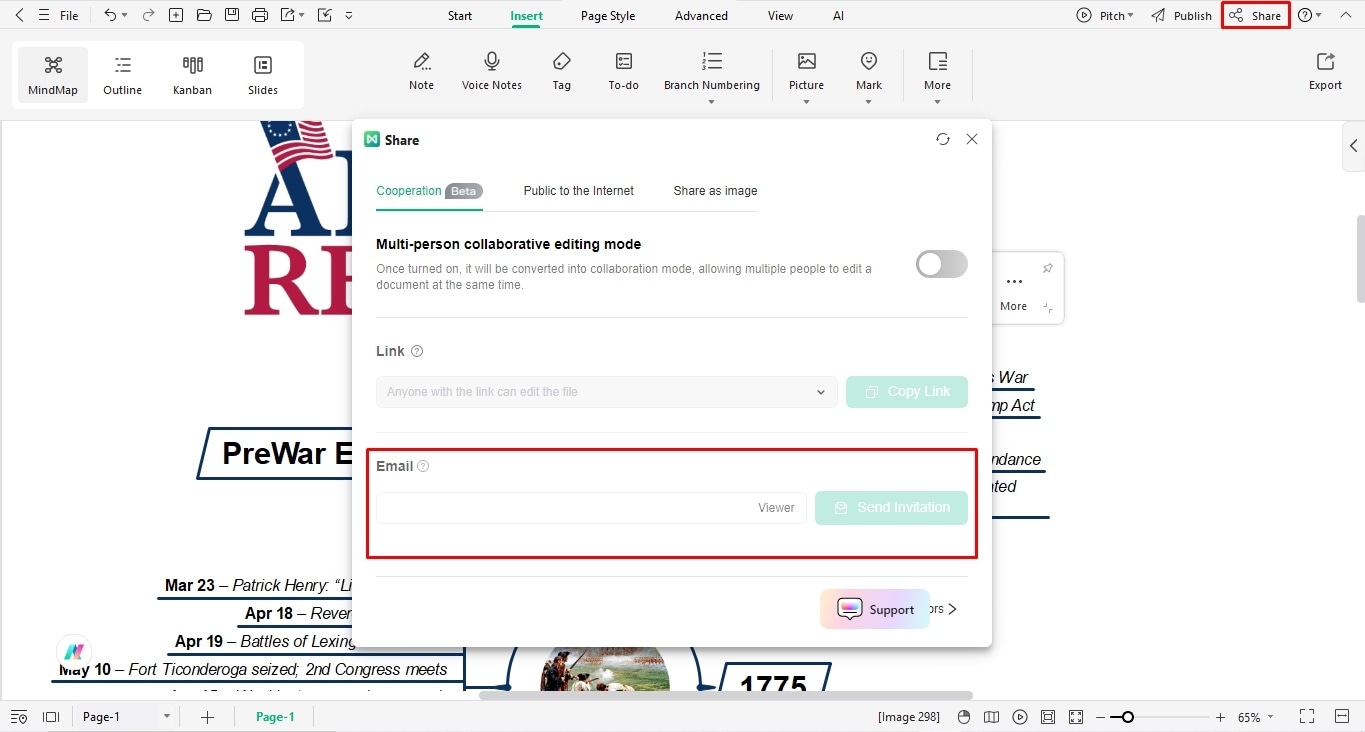
Conclusion
The American Revolutionary War timeline - one of the most complex and extensive wars captured in a diagram. It provides readers with a clear understanding of the chronology of events, enabling them to grasp the interests of the parties involved.
You can also plot similar infographics with EdrawMind. Its preset structures and advanced toolkit are a must-have for students and professionals. Give it a shot and see if it works for you.




